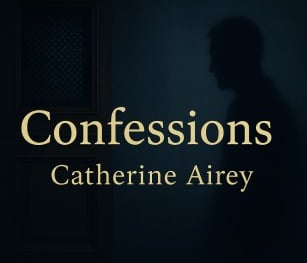Confessions by Catherine Airey
BOOKS REVIEW
Chaifry
7/23/20256 min read


Catherine Airey’s debut novel, Confessions, is a luminous exploration of three generations of Irish women navigating secrets, trauma, and redemption across New York and rural Ireland. Airey, an Anglo-Irish author who wrote this novel in County Cork after leaving her London job, crafts a multigenerational saga spanning the 1970s to 2023, weaving the lives of Cora Brady, her mother Máire, her aunt Róisín, and her daughter Lyca. Set against historical moments like 9/11, the novel delves into sisterhood, motherhood, and bodily autonomy, using experimental elements like second-person perspectives and a retro-style video game.
This review argues that Confessions is essential for its emotionally resonant portrayal of women’s resilience and innovative storytelling. Its blend of intimate character studies and socio-political commentary on abortion rights, mental health, and immigration makes it a vital contribution to contemporary literature. The universal themes of love, loss, and self-discovery, paired with vivid settings and complex characters, compel readers to engage with human connection’s messy truths. This review will summarize the novel’s key elements, critically analyze its strengths and weaknesses, and conclude with its significance, particularly for Indian youth readers seeking narratives of identity and agency.
Confessions opens with a stark image: “Two days after she disappeared most of my mother’s body washed up in Flushing Creek” (Airey, 2025, p. 1). Sixteen-year-old Cora Brady, a rebellious Manhattan teen, grapples with her mother Máire’s suicide seven years earlier when 9/11 claims her father, Michael, an accountant in the World Trade Center’s North Tower: “I taped his poster to columns and bridges, but he was gone” (Airey, 2025, p. 15). Orphaned, Cora spirals into drug use, reflecting, “It doesn’t matter how many people you know or where you go, you’re left with yourself” (Airey, 2025, p. 28). A letter from her estranged aunt Róisín in Burtonport, County Donegal, invites her to Ireland to uncover her family’s hidden history.
The narrative shifts to the 1970s, tracing Máire and Róisín’s lives in rural Ireland. Máire, a gifted artist, struggles with mental health and societal constraints, as Róisín questions, “I used to think that art would be the thing that saved her, but maybe it messed her up?” (Airey, 2025, p. 82). Róisín, a writer, feels overshadowed, confessing, “She was the only one allowed to change, I was supposed to stay the same” (Airey, 2025, p. 110). Máire joins the Atlantis Primal Therapy Commune, nicknamed the “Screamers,” as an artist-in-residence, where her relationship with Michael Brady, a Black Irish boy, strains the sisters’ bond: “For so long she’s been between us—always there, even half the world away” (Airey, 2025, p. 187).
Máire’s move to New York on an art scholarship brings challenges, including an unwanted pregnancy and prejudice: “People do love to make assumptions and I do love to misdirect rather than be transparent” (Airey, 2025, p. 145). Her second-person narrative captures her detachment: “You walk home from midnight mass and shut yourself in a phone box, reminded of the confessional booth” (Airey, 2025, p. 160). Róisín becomes entangled with the Screamers’ house, now owned by an abortionist, and creates Scream School, a video game that weaves through the novel: “You input the command to move the story along” (Airey, 2025, p. 200).
In 2023, Lyca, Cora’s daughter, grapples with her family’s legacy of secrets, noting, “Maybe all stories are more to do with the why than the what, ever thought about that?” (Airey, 2025, p. 320). Cora becomes a pro-choice activist, acknowledging, “We are only as sick as our secrets” (Airey, 2025, p. 350). The novel explores unintended pregnancies, mental illness, and belonging, concluding with redemption as Lyca reflects, “To live our lives not together but apart” (Airey, 2025, p. 420).
Confessions is a bold narrative weaving three generations with emotional depth and stylistic innovation. Airey excels in crafting distinct characters. Cora’s raw voice captures grief, as in “I taped his poster to columns and bridges, but he was gone” (Airey, 2025, p. 15). Máire’s second-person perspective conveys her detachment, as seen in “You walk home from midnight mass and shut yourself in a phone box, reminded of the confessional booth” (Airey, 2025, p. 160). Róisín’s introspective tone, marked by “She was the only one allowed to change, I was supposed to stay the same” (Airey, 2025, p. 110), adds quiet resilience.
The non-linear structure and shifting perspectives create a layered narrative, with the Scream School video game offering a novel metafictional device: “You input the command to move the story along” (Airey, 2025, p. 200). Airey’s prose is lyrical yet precise, evoking settings from 1970s Donegal to post-9/11 New York, as in Cora’s observation, “It doesn’t matter how many people you know or where you go, you’re left with yourself” (Airey, 2025, p. 28). Her compassionate portrayal of abortion and mental health avoids didacticism, particularly in Máire’s struggle: “People do love to make assumptions and I do love to misdirect rather than be transparent” (Airey, 2025, p. 145). The theme of sisterhood, articulated in “For so long she’s been between us—always there, even half the world away” (Airey, 2025, p. 187), resonates deeply, highlighting enduring bonds and conflicts.
The novel’s frequent timeline and perspective shifts can be disorienting, with pivotal moments occurring off-page. Cora’s narrative, starting with “Two days after she disappeared most of my mother’s body washed up in Flushing Creek” (Airey, 2025, p. 1), is abruptly abandoned after her move to Ireland, leaving her later life vague. Máire’s second-person sections, while evocative, create detachment, as in “I used to think that art would be the thing that saved her, but maybe it messed her up?” (Airey, 2025, p. 82), compared to Cora’s vivid first-person voice. The Scream School device feels underutilized, with snippets like “You input the command to move the story along” (Airey, 2025, p. 200) more decorative than integral.
The recurring unintended pregnancies across generations stretch credibility, and Cora’s pro-choice activism feels underdeveloped, as does her acknowledgment, “We are only as sick as our secrets” (Airey, 2025, p. 350). Lyca’s 2023 sections, such as “Maybe all stories are more to do with the why than the what, ever thought about that?” (Airey, 2025, p. 320), lack the earlier narratives’ intensity, leading to a less engaging conclusion.
Why Indian Youth Readers Must Read This Book
Confessions resonates deeply with Indian youth, where family dynamics and societal expectations often clash with personal agency. The intergenerational trauma, reflected in “For so long she’s been between us—always there, even half the world away” (Airey, 2025, p. 187), mirrors the weight of familial legacies in India. The complex sisterhood between Máire and Róisín speaks to maintaining individual identity within collective obligations.
The novel’s focus on women’s autonomy, particularly reproductive rights, is relevant in India, where such discussions are fraught. Máire’s struggle, as in “People do love to make assumptions and I do love to misdirect rather than be transparent” (Airey, 2025, p. 145), echoes young Indians confronting conservative norms. Cora’s activism reflects growing advocacy for gender equality among Indian youth.
Cora’s displacement, articulated in “It doesn’t matter how many people you know or where you go, you’re left with yourself” (Airey, 2025, p. 28), parallels the isolation of Indian youth navigating urbanization or diaspora. The settings evoke Indian cities like Delhi, where history and modernity collide. Máire’s mental health struggles, as in “I used to think that art would be the thing that saved her, but maybe it messed her up?” (Airey, 2025, p. 82), address a growing concern in India, encouraging empathy in a culture where stigma persists.
The Scream School game, with “You input the command to move the story along” (Airey, 2025, p. 200), appeals to tech-savvy Indian youth, offering a fresh narrative lens. Lyca’s realization, “Maybe all stories are more to do with the why than the what, ever thought about that?” (Airey, 2025, p. 320), inspires readers to find meaning despite setbacks. Confessions encourages Indian youth to embrace their complexities, making it an essential read for navigating tradition, modernity, and self-discovery.
Confessions is a remarkable debut blending lyrical prose, psychological depth, and ambitious storytelling. Its vivid characters and innovative structure, as seen in “We are only as sick as our secrets” (Airey, 2025, p. 350) and “To live our lives not together but apart” (Airey, 2025, p. 420), ensure its impact despite fragmented pacing and an underutilized video game device. Airey’s exploration of trauma and autonomy marks her as a promising talent. This novel is recommended for readers who relish multigenerational sagas tackling complex themes with clarity, offering a rewarding experience for those navigating its intricate structure.
